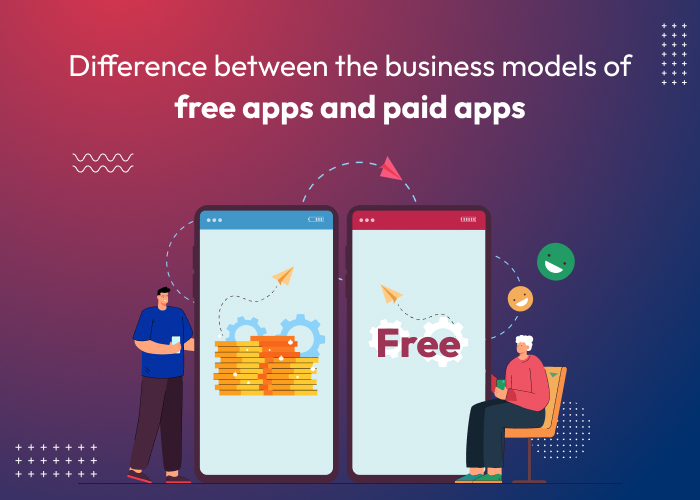Difference between the business models of free apps and paid apps

Well, 88% of mobile time is spent on apps as mentioned in the post by Emarketer. Generally, when it comes to the majority of downloads for free applications, the number rises. Businesses must understand how the business model of free and paid apps works. Below is a detailed explanation:
Revenue Generation:
- Free Apps: They typically rely on alternative revenue streams such as advertising, in-app purchases, subscription models, or sponsored content to generate income. We will get into this in detail later.
- Paid Apps: Paid apps, on the other hand, generate revenue directly from the sale of the app itself. Users are required to pay a one-time fee upfront to download and access the app’s full functionality. Once the app is purchased, users usually have unlimited access to its features without any additional charges.
User Acquisition and Retention:
- Free Apps: They often have a larger user base initially due to their no-cost barrier to entry.
- Paid Apps: Paid apps have a smaller potential user base compared to free applications because users must pay upfront to download them. However, paid apps may benefit from higher user engagement and loyalty since users have already made a financial commitment.
Monetization Strategies:
- Free Apps: They employ various monetization strategies such as advertising, in-app purchases, and sponsored content.
- Paid Apps: Paid apps generate revenue primarily through the sale of the app itself. They may also offer additional paid features or content within the app as optional purchases. However, paid apps generally rely less on in-app advertising since users have already paid for the app upfront.
Market Dynamics:
- Free Apps: They dominate the app market in terms of download numbers and user engagement.
- Paid Apps: Paid apps represent a smaller portion of the overall app market. Competition among paid apps may be less intense compared to free applications, but developers must carefully consider pricing strategies to attract users without pricing themselves out of the market.
How do I monetize my free apps?
There are various strategies to monetize free apps. Below are the proven ways that businesses follow to have significant financial growth on their apps.
- In-App Advertising: Ad networks such as Facebook Audience Network, Google AdMob, and other mobile ad platforms should be integrated into your app. Every time a user views or clicks on an advertisement within your app, you can get paid.
- Freemium Model: Give users the choice to pay for premium features or content through in-app purchases, or offer your app for free with restricted features or content. With this strategy, people may download and test your software before deciding to buy it.
- In-App Purchases: Within your app, provide virtual products, upgrades, or extra content for sale. Items that improve the user experience, such as extra levels, unique power-ups, or exclusive material, may fall under this category.
- Subscription Model: Offer subscription-based access to premium features, content, or services within your app. This model provides a recurring revenue stream as users pay a subscription fee on a regular basis to access your app’s offerings.
- Sponsorships and Partnerships: Collaborate with other businesses or brands to sponsor certain features or content within your app.
- Data Monetization: Collect user data and leverage it for targeted advertising, market research, or selling insights to third-party advertisers or businesses.
- Offering Premium Support or Services: Provide additional support services, consultations, or training for users who require personalized assistance or guidance with your app. You can charge a fee for these premium services.
- Referral Programs: Implement referral programs where users can earn rewards or discounts for referring new users to your app. This can help incentivize user acquisition and drive organic growth.
Conclusion
Free apps have made a big impact in the very competitive mobile app industry by using a variety of monetization techniques. Free applications rely on other income streams including advertising, in-app purchases, subscriptions, and sponsorships, in contrast to premium apps, which make money directly from upfront sales. These tactics enable free apps to draw in a bigger user base at first and offer chances for ongoing expansion and revenue generation.
FAQs
How do free apps compete with paid apps?
Free applications attract users with no upfront cost, leveraging alternative monetization strategies such as advertising, in-app purchases, and subscriptions. This allows them to compete effectively with paid apps while reaching a larger user base.
What is the advantage of offering a free application?
Offering a free app eliminates the barrier to entry for users, encouraging more downloads and increasing the potential for user engagement and monetization through various revenue streams.
Which monetization strategy is the most effective for free apps?
The most effective monetization strategy for a free application depends on factors such as the app’s target audience, features, and content. In-app advertising, freemium models, and subscription services are popular choices, but the optimal strategy may vary for each app.
How can free apps maintain user satisfaction while monetizing?
Free applications can maintain user satisfaction by offering valuable content or features for free, ensuring non-intrusive advertising experiences, providing transparent pricing for in-app purchases or subscriptions, and continuously improving the app based on user feedback.
Are there any risks associated with monetizing free apps?
While monetizing free applications can be lucrative, there are risks such as potential backlash from users due to intrusive advertising, concerns about privacy with data monetization, or competition from similar apps offering similar features for free. Developers must carefully balance monetization efforts with maintaining a positive user experience.
Ravi Bhojani is the Chief Marketing Officer (CMO) at Alian Software, where he spearheads the company’s marketing strategies and drives its brand presence in the competitive IT services landscape. With over a decade of experience in the technology and marketing sectors, Ravi has consistently demonstrated his ability to blend innovative marketing techniques with deep industry knowledge to deliver outstanding results.